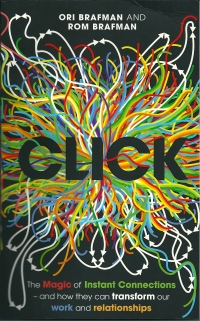What Should I Read Next? – CLICK by Ori and Rom Brafman
Nick Michelioudakis, Greece
Nick Michelioudakis has been a Teacher Trainer for many years. His interests include Motivation and Social and Evolutionary Psychology. He regularly posts comedy clips on YouTube under ‘Comedy for ELT’. To see more of his work, you can visit his site at
www.michelioudakis.org

No way!: OK – this study completely blew my mind! Q: Would you pour your heart out to a machine? A: Of course not. Nor did the subjects in a study where a computer asked them Qs like ‘Have you ever felt guilty about something?’ But when the computer was programmed to ‘disclose things’ before asking (e.g. ‘This computer sometimes crashes for no apparent reason’) things changed dramatically! Not only did the subjects share a lot more, but they also evaluated the machine (the machine, mind you!) as ‘likeable, friendly, kind and helpful’! Amazing! (p. 46)

Menu
Five key elements
Disclosure
Proximity
Similarity
Does ‘clicking’ matter?
So how can we start?
The Brafman brothers explore the fascinating question of what it is that makes people instinctively connect with each other and they look at 5 key elements: vulnerability, proximity, resonance, similarity and a safe place. All five are important, but I am going to consider only three here.
The computer study illustrated the importance of ‘vulnerability’ – making yourself vulnerable by means of disclosure. Disclosure is a central concept in ‘Click’ (pp. 38 – 41). But not all disclosure is the same; apparently there are 5 levels: i) phatic ii) factual iii) evaluative iv) gut-level and v) peak. The first 3 are ‘transactional’; it’s the other two that are the important ones however – these are called ‘connective’ and for good reason: they bring people closer. [Moral: it pays to gradually push the envelope in humanistic activities and get people to disclose more intimate thoughts and feelings. It can work wonders.]
Proximity – as in ‘physical proximity’ leads to liking. This may well be the ‘mere exposure effect’ at work. The more we are exposed to something, the more we endow it with positive values (p. 75). Studies have shown that police cadets tend to like others whose surname starts with the same initial (because they sit close to each other! – p. 60) Chit-chat is also hugely important for building group cohesion (e.g. at the company cafeteria, the school yard or the water-cooler). Alas, online communication tends to be transactional and the bonding that this chit-chat fosters is lost (p. 72) [ Something for us to bear in mind in online courses…]
We all know that similarity facilitates bonding, but the book offers two extra insights: Q: The more important the similarities (e.g. values, beliefs etc.), the stronger the bond will be, right? A: Wrong! With similarities it’s quantity not quality that counts! (p. 110) Here is another little thing: the less common these similarities are, the better. If we both like the ‘Beatles’, that’s good; but if we both like the ‘Tindersticks’, that’s a lot better (p. 117). [Moral for teachers: if we want to bond with students or with colleagues, it pays to seek out similarities – the more, the better!]
Intuitively we all know it does, and research confirms our hunches: in a revealing study, first-year MBA students were asked to nominate up to 10 classmates they felt close to. On the basis of this information, the researchers formed 3-person teams. Some consisted of people who knew and liked each other, while others consisted of mere acquaintances. Unsurprisingly, the former clearly outperformed the latter in two successive tasks measuring both output and quality of work (pp. 175 – 177).
Here is an idea: Following the 9/11 attacks, Ori Brafman got involved with a group of CEOs who wanted to help their country. To get them to bond as a group, he gave them a simple task, namely to introduce themselves to each other and then share the single best and worst moment in their lives. The first bit was easy; but the second was a bit of a gamble – would one share one’s divorce or the death of a family member with a stranger? Yet it worked like a charm! Disclosure had done it again… (pp. 139 – 141).

Please check the Building Positive Group Dynamics course at Pilgrims website.
Please check the How the Motivate your Students course at Pilgrims website.


|